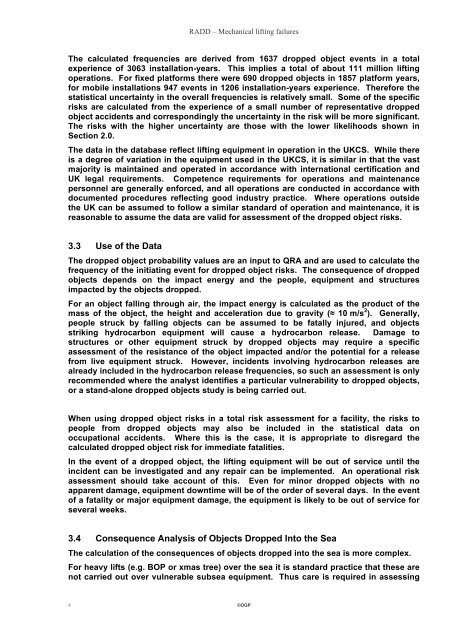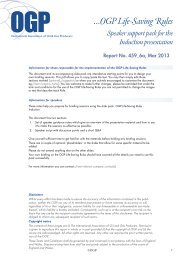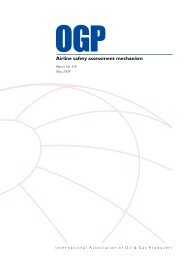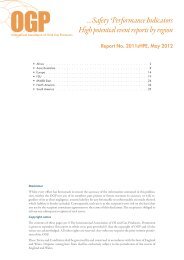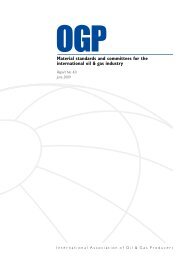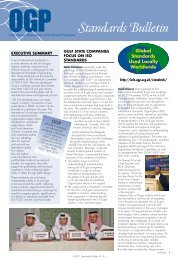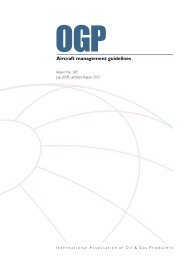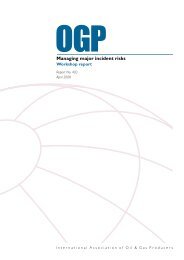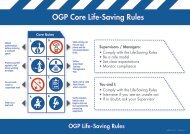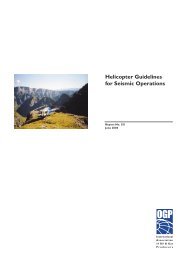Mechanical lifting failures - OGP
Mechanical lifting failures - OGP
Mechanical lifting failures - OGP
Create successful ePaper yourself
Turn your PDF publications into a flip-book with our unique Google optimized e-Paper software.
RADD – <strong>Mechanical</strong> <strong>lifting</strong> <strong>failures</strong><br />
The calculated frequencies are derived from 1637 dropped object events in a total<br />
experience of 3063 installation-years. This implies a total of about 111 million <strong>lifting</strong><br />
operations. For fixed platforms there were 690 dropped objects in 1857 platform years,<br />
for mobile installations 947 events in 1206 installation-years experience. Therefore the<br />
statistical uncertainty in the overall frequencies is relatively small. Some of the specific<br />
risks are calculated from the experience of a small number of representative dropped<br />
object accidents and correspondingly the uncertainty in the risk will be more significant.<br />
The risks with the higher uncertainty are those with the lower likelihoods shown in<br />
Section 2.0.<br />
The data in the database reflect <strong>lifting</strong> equipment in operation in the UKCS. While there<br />
is a degree of variation in the equipment used in the UKCS, it is similar in that the vast<br />
majority is maintained and operated in accordance with international certification and<br />
UK legal requirements. Competence requirements for operations and maintenance<br />
personnel are generally enforced, and all operations are conducted in accordance with<br />
documented procedures reflecting good industry practice. Where operations outside<br />
the UK can be assumed to follow a similar standard of operation and maintenance, it is<br />
reasonable to assume the data are valid for assessment of the dropped object risks.<br />
3.3 Use of the Data<br />
The dropped object probability values are an input to QRA and are used to calculate the<br />
frequency of the initiating event for dropped object risks. The consequence of dropped<br />
objects depends on the impact energy and the people, equipment and structures<br />
impacted by the objects dropped.<br />
For an object falling through air, the impact energy is calculated as the product of the<br />
mass of the object, the height and acceleration due to gravity (≈ 10 m/s 2 ). Generally,<br />
people struck by falling objects can be assumed to be fatally injured, and objects<br />
striking hydrocarbon equipment will cause a hydrocarbon release. Damage to<br />
structures or other equipment struck by dropped objects may require a specific<br />
assessment of the resistance of the object impacted and/or the potential for a release<br />
from live equipment struck. However, incidents involving hydrocarbon releases are<br />
already included in the hydrocarbon release frequencies, so such an assessment is only<br />
recommended where the analyst identifies a particular vulnerability to dropped objects,<br />
or a stand-alone dropped objects study is being carried out.<br />
When using dropped object risks in a total risk assessment for a facility, the risks to<br />
people from dropped objects may also be included in the statistical data on<br />
occupational accidents. Where this is the case, it is appropriate to disregard the<br />
calculated dropped object risk for immediate fatalities.<br />
In the event of a dropped object, the <strong>lifting</strong> equipment will be out of service until the<br />
incident can be investigated and any repair can be implemented. An operational risk<br />
assessment should take account of this. Even for minor dropped objects with no<br />
apparent damage, equipment downtime will be of the order of several days. In the event<br />
of a fatality or major equipment damage, the equipment is likely to be out of service for<br />
several weeks.<br />
3.4 Consequence Analysis of Objects Dropped Into the Sea<br />
The calculation of the consequences of objects dropped into the sea is more complex.<br />
For heavy lifts (e.g. BOP or xmas tree) over the sea it is standard practice that these are<br />
not carried out over vulnerable subsea equipment. Thus care is required in assessing<br />
4<br />
©<strong>OGP</strong>


